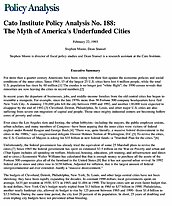In recent years the departure of businesses, jobs, and middle-income families from the old central cities has begun to resemble a stampede. For example, since the late 1970s more than 50 Fortune 500 company headquarters have fled New York City. A stunning 370,000 jobs left the city between 1989 and 1992, and another 130,000 were expected to disappear by the end of 1992.[3] Cleveland, Detroit, Philadelphia, St. Louis, and other major U.S. cities are also suffering from severe out-migration of capital and people. Those once-mighty industrial centers are becoming hollow cores of poverty and crime.
Ever since the Los Angeles riots and looting, the urban lobbyists–including the mayors, the public employee unions, urban scholars, and many members of Congress–have been arguing that the inner cities were victims of federal neglect under Ronald Reagan and George Bush.[4] “There was, quite literally, a massive federal disinvestment in the cities in the 1980s,” says congressional delegate Eleanor Holmes Norton of Washington, D.C.[5] To revive the cities, the U.S. Conference of Mayors is asking for $35 billion in new federal funds–a “Marshall Plan for the cities.”[6]
Unfortunately, the federal government has already tried the equivalent of some 25 Marshall plans to revive the cities.[7] Since 1965 the federal government has spent an estimated $2.5 trillion on the War on Poverty and urban aid. (That figure includes all spending on welfare, Medicaid, housing, education, job training, and infrastructure and direct aid to cities.) Economist Walter Williams has calculated that that is enough money to purchase all the assets of the Fortune 500 companies plus all of the farmland in the United States.[8] But it has not spurred urban revival. In 1992 federal aid to states and cities rose to $150 billion. Adjusted for inflation, that is the largest amount of federal intergovernmental aid ever extended–hardly a “massive disinvestment.”
The budgets of Cleveland, Detroit, Philadelphia, New York, St. Louis, and other large central cities have not been shrinking; they have been rapidly expanding for decades. In constant 1990 dollars, local governments spent, on average, $435 per resident in 1950, $571 in 1965, and $1,004 in 1990. The largest cities saw an even faster budget rise. In real dollars, New York City’s budget nearly tripled from $13 billion in 1965 to $37 billion in 1990. Philadelphia, another nearly bankrupt city, allowed its budget to rise by 125 percent between 1965 and 1990–from $1.6 billion to $3.5 billion. During the same time period, the city lost 20 percent of its population. In short, 25 years of doubling and even tripling city budgets have not prevented urban bleeding.
Not all U.S. cities are in decline. Among the nation’s largest urban areas there are dozens of cities–many on the West Coast, in the Sunbelt, and in the Southeast–that have been booming financially and economically for at least the past 20 years. Las Vegas, Nevada; Phoenix, Arizona; Arling- ton and Austin, Texas; Sacramento and San Diego, California; Raleigh and Charlotte, North Carolina; and Jacksonville, Florida, all have rapidly rising incomes, populations, and employment and low poverty and crime rates.
The key policy question addressed in this study is, What do growth cities–Phoenix, Raleigh, and San Diego, for example–do differently from shrinking cities–such as Buffalo, Cleveland, and Detroit? The answer is found, at least partially, in the fiscal policies of the cities. Using Bureau of the Census city finance data from 1965, 1980, and 1990 for the 76 largest cities, we find significant and consistent patterns of higher spending and taxes in the low-growth cities than in the high-growth cities. Table 1 highlights the difference between the fiscal policies of the 10 cities with the greatest growth in population in the 1980s and the 10 largest urban population losers. The data in Table 1 support the following findings.

